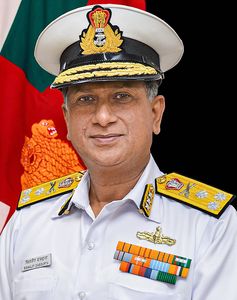THE NAVY IS sometimes called the strategic service. This moniker is not easily applied to the other two services, the Army and the Air Force since their influence is often limited by geography and scale of interaction. The Indian Navy, on the other hand, is a truly global force which is distinctly international in character. This is not a new phenomenon. The characteristics of naval forces make them eminently suited for tasks well beyond the horizon, carrying friendships across the oceans and, if necessary, delivering lethal power to engage adversaries far away from own shores or assisting people in need such as our own diaspora in times of crises.
Besides being the primary manifestation of national maritime power, the Navy’s contribution in furthering the nation’s foreign policy has been stellar. Of the major roles of the Navy, its diplomatic role is the most visible and effective in the international maritime arena. From humble beginnings, this role has steadily grown in tandem with our ever-expanding global influence and diplomatic outreach. MILAN, a biennial maritime congregation of world navies, conducted by the Indian Navy, is a manifestation of this reality.
MILAN, as the name suggests, is a meeting of sorts. The idea germinated in the early 1990s, when a small conclave of navies of the eastern littoral of the Indian Ocean met once every two years at Port Blair. Just four regional navies participated in the first edition in 1995, represented by a small delegation. Later, one or two ships from friendly navies would call at Port Blair to coincide with the event. It was then more an ‘ice-breaking’ event with little operational content. MILAN steadily grew in strength and stature, with increasing participation by regional navies and much richer content. In 2018, 17 navies congregated at Port Blair. The normally harbour-based interactions expanded to include a sea phase of exercises.
With increasing participation and content, MILAN shifted to the picturesque port city of Visakhapatnam, the headquarters of the Eastern Naval Command. This was done for ease of logistics on the mainland. MILAN 2020 was planned on a large scale, but was called off because of the pandemic. MILAN 2022 saw a tectonic shift in the complexion of the event with 39 foreign navies, 13 foreign warships and one foreign maritime patrol aircraft participating, besides high-level delegations, many led by chiefs of navies. Apart from a rich operational content, there was a vibrant cultural exchange, city parades, exhibitions and much pageantry. It altered the perception of the Indian Navy to one that had ‘arrived’ on the world stage.
MILAN 2024 promises to be a ‘never before’ event. A nine-day interaction among world navies from February 19 expects to witness 50 navies in attendance with 15 ships and one aircraft from friendly countries, along with more than 20 Indian naval platforms, including both aircraft carriers, Vikramaditya and Vikrant. The scope and complexity of the interaction will see an exponential enrichment. A defence technology expo, cultural events, seminars and public interaction including a city parade will also be integral components of this global naval interaction.
MILAN, which started as a small meeting of a few navies, has metamorphosed into a signature event that has paid the nation rich diplomatic and maritime dividends. It has cemented the Indian Navy’s reputation as a prominent force that stands for cooperation, peace and good order at sea, in keeping with the nation’s maritime vision and aspirations.
The author is former commander-in-chief of the Eastern Naval Command.



